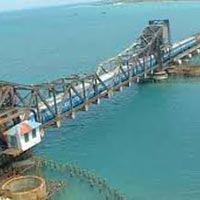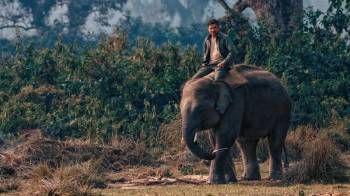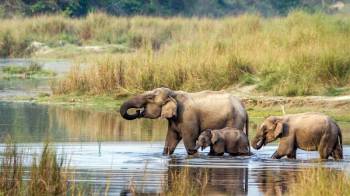+91-8929175340
Kathmandu UNESCO listed world heritage sites,naturally,culturally and historically well known Sankhu and Changunarayan,Bhaktapur which is one of the beauty of nepalese art and culture.We will be driven to the hill top of Nagarkot for close mountain views and enormous sunrise view.This package is suitable for the visitors who have less time to spend and is also economically viable.Services not mentioned in the above itinerary.
Entrance fees to Sightseeing Places.
Tips & gratuities.
Personal expenses, lunch, dinner, beverages.
Porterage at the airport.
12-0630-06
Day 1 : Airport arrival.Meet,assist and transfer to the hotel by our office representative
Transfer to the hotel by exclusive A/C vehicle.Evening can be utilized for a short walk around the hotel.
Day 2 : Kathmandu sightseeing
After breakfast around 7:30 we start our full day sightseeing of Kathmandu valley which are briefly stated belows.
1.Pashupatinath:
The magnificent temple of Lord Pashupatinath about 5 kms north-east of Kathmandu, is situated amidst many other temples on the right bank of the river Bagmati. Pashupathinath is the guardian spirit and the holiest of all Shiva shrines in Nepal.Lord Shiva is known by many different names; and Pashupati is one. Pashu means leaving beings, and Pati means master. In other words Pashupati is the master of all living beings of the universe. This is how lord Pashupati is eulogized in the Vedas, Upnisada and ohter religious books.The oldest ever chronicle in Nepal, Pashupati area is regarded as one of the most important places of pilgrimages for the followeres of Hinduism.
2.Boudhanath Stupa:
Boudhanath Stupa (or Bodnath Stupa) is the largest stupa in Nepal and the holiest Tibetan Buddhist temple outside Tibet. It is the center of Tibetan culture in Kathmandu and rich in Buddhist symbolism. The stupa is located in the town of Boudha, on the eastern outskirts of Kathmandu. Bodnath was probably built in the 14th century after the Mughal invasions; The five Buddhas also personify the five elements (earth, water, fire, air and ether), which are represented in the stupa's architecture. The base of the stupa consists of three large platforms, decreasing in size. These platforms symbolize Earth, and here you can look out at the mountains while listening to the chants of the devout doing kora, walking around the stupa praying.
3.Syambhunath Stupa:
After lunch we head atop a hill on the western edge of the Kathmandu Valley, the ancient Swayambunath Stupa (known to tourists as the Monkey Temple) is Kathmandu's most important Buddhist shrine. The sleepy, all-seeing Buddha eyes that stare out from the top have become the quintessential symbol of Nepal. hen this temple was founded about 2,000 years ago, Kathmandu Valley was filled with a great lake. According to Buddhist legend, a single perfect lotus grew in the center of the lake. When the bodhisattva Manjusri drained the lake with a slash of his sword, the lotus flower settled on top of the hill and magically transformed into the stupa. Thus it is known as the Self-Created (swayambhu) Stupa. The earliest written record of the Swayambunath Stupa's existence is a 5th-century stone inscription, but scholars believe there was probably a shrine here as early as the 1st century. Even before that, it is likely that animist rites took place on this hill. Swayambunath is one of Nepal's oldest Buddhist temples and it has an ancient atmosphere, especially when one approaches on foot with the pilgrims. The primary approach to the temple is from the eastern side, where 365 ancient steps lead up the steep forested hillside. The base is about a 20-minute walk from the center of Kathmandu. This staircase is the only route pilgrims would consider and is the most memorable way for any visitor to experience the stupa. However, an alternative is to drive or take a taxi to the west side, where there are only a few steps to climb to the top.
4.Budhanilakantha Temple:
Budhanilkantha Temple is located at the base of Shivapuri Hill within the Kathmandu valley on the northern side. It is also known as mystical Budhanilkantha temple or Narayanthan temple .Budhanilkantha literally means “Old Blue Throat”. It is only nine kilometer away from the main city. It is a deity of Lord Vishnu; Lord Vishnu is also known as Narayan.It is called Vishnu (Narayan) Jalasayan lying on Ananta Sesa, in the cosmic ocean. The deity is about thousand years old. Lord Vishnu is about five meter (Seventeen fits) long and lying in a thirteen meter (forty three fits) long tank, as if floating with his legs crossed with his sleeping body resting on the coils of Ananta and his 11 hooded head.His four hands hold the four symbols of Vishnu, the Shankha as conch shell, Chakra as disc,Gadha as club and Padma as lotus flower. It is believe that the deity was carved in the seventh or eighth century during the Licchavi period. Hindus can walk down the steps and touch his feet. It is with the sacredness of this particular god that a deep seated belief was created by King Pratap Malla through a prophetic dream. It was his strong belief and fear that should the King of Nepal visit the Budhanilkantha temple, death would be threatening immediately to fall upon his departure. The two other images of the deity which were carved during the same time lie at two particular destinationa, the Balaju Garden were public viewing can take place and the beautiful Royal Palace in Kathmandu.It is here at Budhanilkantha temple, however that public is not permitted.
End of tour day 1.Overnight stay at a hotel in Kathmandu.
Day 3 : Kathmandu-Sankhu-Changunarayan
After breakfast around 7:30 we start our full day sightseeing of Sankhu and Changunarayan which is briefly stated belows.
Sankhu and Changunarayan(Mandev Temple):
Sankhu is an old and historical trading town situated about 17 km northeast of Kathmandu on the ancient trade route to Tibet. The foundation of the kingdom of Sankhu is attributed to the goddess Vajrayogini, whose shrine is located in the forest above the town of Sankhu. The temple of Vajrayogini is an important pilgrimage site for Buddhists and Hindus alike. The yearly festival of the goddess is also the main event in Sankhu's ritual cycle. According to the legend Manisailamahavadana, Vajrayogini instructed the priest Jogdev and the first king Sankhadev to build the town of Sankhu in the shape of a conch shell. The oldest inscription found in Sankhu is dated 538 AD.
After the opening of alternative trade routes to Tibet the town lost in importance. Nowadays Sankhu is a mainly agricultural town, which offers a medieval sight in spite of its proximity to Kathmandu. Sankhu’s surrounding villages; Lapsephedi and Nanglebhare Village Development Committees are the most remote and backward areas of Kathmandu. Sankhu as an ancient town consists numerous historical monuments. In the past, wealthy individuals, religious groups or families used to build such monuments to obtain religious merits.The Mahadevadhvaka square, with the Mahadev temple and its Shiva shrine (phallus), holy pond, and numerous shrines of other deities, is one of the most sacred religious sites in Sankhu. he two-roofed Mahadeva temple is a magnificent example of a Newar pagoda-style temple. Its roofs are made of traditional tiles called ayapa and its walls are built with traditional bricks called dachiapa. The temple has a square shape and is surrounded by four walls. On the ground floor it has four wooden doors facing toward the four main directions, above each door is placed a semi-circled wooden tympanum decorated with various figures. Only the gate facing south is opened as the entrance to the temple for the public, while the other three gates remain closed. Inside the temple, at the centre of the ground floor a stone phallus (linga) attached to a female organ (yoni). Devotees in Sankhu worship the shrine by offering water, flowers, coloured powders, vegetables and other items. Wooden frames and wooden struts support the diagonally attached roofs of the temple. A special kind of tile (ayapa) is used on the roofs to protect it from the rain. Wooden struts are connected to the temple walls and roofs. They are carved with various religious images. Twelve wooden struts are attached to support the first roof from the ground. On each corner there is a strut with an animal figure. The eight struts placed at the centre of the walls depict Bhairava, the god of death. Each of the Bhairava is in a different mood, so they are known as eight Bhairava (astabhairava). Bhairava is also considered to be one of the forms of Shiva himself. At the bottom of each of these struts, images of copulating human couples are depicted. Such erotic symbols on temples are common in Nepal, especially on Shaiva temples. Some people believe that such symbols are carved to protect the temple from lightning, while others believe that they carry tantric value. Many also believe that it was a way of educating people about sex. Below the roof, in the middle of each wall, a wooden window is attached. The top roof and walls are smaller in size but similar in structure, and the wooden struts are decorated with different figures. On the top of the temple a brass pinnacle is fixed.
In addition to the temple of Mahadev there are numerous other statues around the Mahadeva square, such as a life size Ganesa, Visnu together with his consorts Laksmi and Sarasvati, Bhimsen, sleeping Visnu (Bhuijasinarayan), Radha and Krsna, Satyanarayana, Triratna, Minaga, Sitalamaju, Caturmukhi Siva, a small stone temple of Siva, Camunda with a troupe of Astamatrka considered to be one of the eight matrka inside the town, Siva-Parvati and several other scattered shrines of Siva. Besides the main temple with its Siva shrine, there are at least fourteen other stone shrines of Siva scattered around this square. Mahadeva pond is another sacred spot in this square.
End of day 2 tour.
Day 4 : Bhaktapur-Nagarkot
After breakfast around 7:30 we start our full day sightseeing of Bhaktapur which is briefly stated belows.
Bhaktapur:
Were there nothing else in Nepal save the Bhaktapur Durbar Square, it would still be aptly worth making a journey half way round the globe to see. E.A. Powell, The Last Home of Mystery, 1929, London
Bhaktapur, between the 14th and the 16th centuries, was the capital of Nepal. Though today it has lost the privilege to Kathmandu, it still retains its culture and traditions, some say, even better than Kathmandu or Patan. One reason is that it is 15kms away from the madding crowd, the choking traffic and the general mayhem of the capital city. During the ancient days, the city was an important business centre as it was located in the bustling trade route to Tibet. The inhabitants were prosperous and self reliant. They were blessed with a fertile soil and the farmers could make enough produce to feed the entire town. The craftsmen were a respected lot and they were entrusted with the task of making the temples really fit for the gods. And by the looks of it, they did extraordinary justice to their responsibilities.
A living heritage’Bhaktapur’ meaning ‘city of devotees’ proudly bears the title of the ‘cultural capital of Nepal’ and lives up to it. Listed as a World Heritage by UNESCO for its exquisite temples, exotic wood carvings and other rococo works in stone and metal, Bhaktapur is in a class of its own. Compared to the other durbar squares, the Bhaktapur Durbar Square is quite spacious. Ironically, this is because of an earthquake that happened in 1934 which destroyed many of the temples and monuments that stood here once. This is a living heritage in every sense. There is even a school inside the premise, the entrance to which is the famous lion gate. Right next to the lions that stand as a possible deterrent for students bunking classes, is the statue of Ugrachandi, one of the masterpieces in stone. Ugrachandi is the fearful manifestation of the consort of Lord Shiva. Bhairab, the fierce avatar of Lord Shiva, associated with annihilation, is revered all over Nepal by both Hindus as well as Buddhists. Bhairab is invoked to destroy and annihilate enemies. The images of Bhairab which you find in the durbar square hence are quite ferocious and intimidating.
The Dattatreya Square named after the triad deities, Brahma the creator, Vishnu the preserver and Maheshwara the emancipator are a delight for those interested in wood carvings. The Square also features some of the finest examples of metal craftsmanship you would ever see. The 55 Windows Palace, built in the 18th century, is made of brick and has an upper floor entirely of wooden windows. Hence, the name. The earthquake of 1934 partially destroyed the palace. Fortunately some of the more exotic carvings were mercifully spared from the fury. The Taleju Bhawani was the preferred deity for the kings here as well. Getting inside the Taleju temple complex is not usually encouraged but you can persuade the armed guards to look the other way. Once inside the complex, you get a foretaste of some imperial preferences. The Mallas, it seems, were as fond of luxuries as they were of their gods. Their swimming pool had an open terrace for sunbathing. The golden spout was for filling the pool with water and the entire pool was outlined like a sprawled snake. Even inside the pool, the kings had set up miniature temples – well, it definitely looked like they had long-lasting bathing sessions.
At the southeastern corner of the royal palace is the Siddhi Lakshmi Temple. This is known as the ‘Lohan Dega’ or the stone temple. The steps leading up to the temple is flanked by the male and female species of animals and two nobles at the bottom, each of them are shown dragging a naked child and a dog. Just five minutes from the Durbar Square is the Taumadhi Square where the legendary Nyatapola temple stands towering elegantly. ‘Nyata’ is Nepali means ‘five stepped’. The Nyatapola, rising to a regal 30 metres, is Nepal’s tallest temple. Balanced on five receding square plinths, there are five balconies over which are five roofs each supported by magnificently carved wooden columns. At the bottom of the steep stairway that leads up to the temple are two wrestlers from the Malla times who were famed for their skill and strength. Further upwards are lions and griffins and statues of goddesses Singhini and Baghini.
The temple was built by King Bhupatindra Malla for his favourite deity the Siddhi Lakshmi. There are 108 wooden beams that support the roof from below, each depicting the goddess in her different forms. However, one strange fact is that despite the size and the allure of the temple, no one has really seen the goddess. The temple offers great views of the durbar square as well as the surrounding areas. The brick red of the square offers a fabulous contrast against the verdant green of the mountain of the valley. Set at right angles to the Nyatapola is the Bhairavnath Mandir. The three-tiered roof which stands against a clear afternoon sun shows off a massive grandeur. The temple, dedicated to the city’s patron god Bhairav is believed to have extraordinary powers which make it a favourite among the locals.
Day 5 : Nagarkot- Kathmandu
After breakfast around 7:30 we start our sightseeing of Nagarkot.
Nagarkot:
Nagarkot is a village located about 25 miles east of Kathmandu, Nepal. It is located on the northeastern rim of the Kathmandu Valley at an elevation close to 6,800 feet above sea level. It is one of the most scenic spots in the region, renowned for its sunrise and sunset views of the Himalayas. You can pick Mount Everest out with its snow-topped peaks on a clear day as there is an observation tower at the very top of the village’s hills.
Nagarkot, historically, used to serve as the summer retreat for the royal family and many other aristocrats from Kathmandu. While the town offers great views of the mountains, there are few monasteries or temples.
However, Nagarkot makes for a good short hike, one in which you walk on the ridge of the valley. It has also become a popular stop for mountain bikers. You can catch a bus for the one-hour ride to Nagarkot from Bhaktapur, Nepal. A taxi will cost about a hundred times more. Most visitors, however, drive up, spend the night at one of the moderately-priced lodges and walk down by any number of routes. From Nargarkot, it takes just less than three hours to walk down a well-worn trail through several villages to Bhaktapur.
Alternatively, in three hours time, you can hike down to Changu Narayan, one of the most magnificent temples in the valley and designated a World Heritage site by UNESCO. The present structure was built in the early 1700's, but at the entrance of the main shrine are stone tablets with the inscriptions dating to 400 AD. Facing the entrance is a 5th century statue of a human-faced Garuda, the mount of Vishnu, who is also called Narayan. There are many other fine statues from the Licchavi era, as well as several from the more recent Malla pe riod, including that of King Bupatindra and his queen in a gilded enclosure from the 17th century. Changu Narayan is also patron ised by the Valley's Buddhists who wor ship Lokeswar (another name for Vishnu).
Nagarkot is the place where once Manjushree Bodhisatto stood and watched the lake in the Kathmandu Valley. Nagarkot is at the eastern periphery of the Kathmandu Valley. The hilltop called Nagarkot at more than 2,000 meters above the sea level is the second highest peak in the Kathmandu Valley. After an hour long exciting and winding drive you will be above to feel the cool breeze of air blowing endlessly into your face, and see the widest range of Himalayas including Mount Everest with our bare eyes from here. It is also one of the best spots to visit for unmatched sunrise and sunset views.And if awesome view is your first preference to visit Nagarkot,then, Peaceful cottage and cafe dumont ,nagarkot ought to be your first port of residence.
Aftrer the sightsseing is over we head back to the hotel in Kathmandu.
Day 6 : Departure
After breakfast we are ready to depart to International airport by our exclusive vehicle as per the flight time and schedule.
| No of pax | Age Limit | Price per pax (Rs) |
|---|---|---|
| Adult | Above 12 years | $ 429 / Adult |
* Mentioned prices may vary depending upon date of travel, hotel availability, surge pricing and seasonal rush.
Three Star Combination
| 2-3 pax | $429.00 |
| 4-10 pax | $344.00 |
| 11-19 pax | $287.00 |
| 20+ | $259.00 |
Four Star Combination
| 2-3 pax | $452.00 |
| 4-10 pax | $368.00 |
| 11-19 pax | $310.00 |
| 20+ | $283.00 |
Five star combination
| 2-3 pax | $600.00 |
| 4-10 pax | $515.00 |
| 11-19 pax | $459.00 |
| 20+ | $430.00 |
Payment Terms & Methods :
* Some Advance Percentage of total booking amount * Airfare/Transport fare to be paid full at one time in advance.
Cancellation & Refund Policy :
* Upon cancellation, refund will be made after deducting the Retention Amount. * Retention Amount varies as per the number of days left before your package start date.
Infinity Tours P. Ltd View Profile
0 / 5
About Infinity Tours P. Ltd

Infinity Tours P. Ltd
0 /5 6D/5N
6D/5N
Madurai - Rameshwaram - Kanyakumari
08047020431
Get Quote 10D/9N
10D/9N
Kathmandu - Lumbini - Chitwan - Pokhara
 14D/13N
14D/13N
Kathmandu - Lukla - Solukhumbu - Namche
 18D/17N
18D/17N
Mumbai - Kathmandu - New Delhi - Jaipur - Fatehpur Sikri - Agra - Jhansi - Varanasi..
08048772512
Get Quote 11D/10N
11D/10N
Kathmandu - Nagarkot - Lumbini - Pokhara - Chitwan
 7D/6N
7D/6N
Kathmandu - Pokhara - Chitwan - Nagarkot - Bhaktapur
08048407069
Get Quote